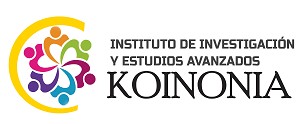WhatsApp como estrategias para fortalecer el trabajo colaborativo
Resumen
El objetivo de la presente investigación es proponer estrategias que fortalezcan el trabajo colaborativo en los estudiantes de básica superior especialmente de zonas rurales con el uso del WhatsApp. Para ello se empleó una metodología descriptiva no experimental transversal, se aplicó encuesta a docentes del circuito 01D06 del cantón Paute. Con los resultados obtenidos se pudo evidenciar que los docentes están de acuerdo en usar el WhatsApp para fomentar el trabajo colaborativo, pero que es indispensable definir normativas para el uso adecuado del mismo. Es así que se realizó una propuesta enfocada en las siguientes estrategias: Trabajo grupal, elaboración de normativas e intercambio de opiniones, que direccionarán y fomentarán las directrices de un trabajo estudiantil dinámico, interactivo, equitativo y tecnológico.
Descargas
Citas
Casillas, S., Cabezas, M., & Hernández, A. (2017). Construcción de conocimiento colaborativo mediado tecnológicamente: Aportaciones teóricas desde el análisis de prácticas educativas. [Technology-mediated collaborative learning: theoretical contributions based on analysis of educational practice]. Teoría de la Educación. Revista Interuniversitaria, 29(2), 61-86.
Colorado, P., & Gutiérrez, L. (2016). Estrategias didácticas para la enseñanza de las ciencias naturales en la educación superior. [Didactic strategies for natural sciences teaching in higher education]. Revista Logos, Ciencia & Tecnología, 8(1), 148-158. Obtenido de https://n9.cl/21k4r
Delgado , M., & Solano, A. (2009). Estratégias didácticas creativas en entornos virtuales para el aprendizaje. [Creative didactic strategies in virtual surroundings for the learning]. Actualidades Investigativas en Educación, 9(2), 1-21.
Gómez, M. (2017). Utilización de WhatsApp para la Comunicación en Titulados Superiores. [WhatsApp Use for Communication among Graduates]. REICE. Revista Iberoamericana sobre Calidad, Eficacia y Cambio en Educación, 15(4), 51-65. doi:https://doi.org/10.15366/reice2017.15.4.003
Marañón, C. (2012). Redes sociales y jóvenes: Una intimidad cuestionada en internet. [Social and youth media: A questioned privacy on the internet]. Aposta. Revista de Ciencias Sociales(54), 1-16. Obtenido de https://n9.cl/agln7
Quispe, W. (2019). Uso de WhatsApp y su valoración en el trabajo colaborativo de estudiantes de la Maestría en Gerencia de Servicios de Salud de la Facultad de Medicina de la Universidad Nacional Mayor de San Marcos, 2019. [Use of WhatsApp and its assessment in the collabora. Universidad Nacional Mayor de San Marcos. Recuperado de https://n9.cl/y7zy
Rodríguez, D. (2020). Más allá de la mensajería instantánea: WhatsApp como una herramienta de mediación y apoyo en la enseñanza de la Bibliotecología. [Beyond instant messaging: WhatsApp as a mediation and support tool in the teaching of Library Science]. Información, Cultura y Sociedad, (42), 107-126. doi:https://doi.org/10.34096/ics.i42.7391
Rubio, J., & Perlado, M. (2015). El fenómeno WhatsApp en el contexto de la comunicación personal: una aproximación a través de los jóvenes universitarios. [The WhatsApp phenomenon in the context of personal communication: an approximation through the university youths]. Revista ICONO14 Revista Científica De Comunicación Y Tecnologías Emergentes, 13(2), 73-94. doi:https://doi.org/10.7195/ri14.v13i2.818
Ruvalcaba, L., Torres, V., Carmona, E., & Pérez, Ó. (2019). Perfil estudiantil: uso de WhatsApp y Facebook. [Student profile: use of Whatsapp and Facebook]. NOVUM, revista de Ciencias Sociales Apliacadas, 1(9), 32-57. Obtenido de https://n9.cl/3f12o
Siemens, G. (2004). Elearnspace. Connectivism: A Learning Theory for the Digital Age. Recuperado de https://n9.cl/5jw3i
Suárez, B. (2017). WhatsApp como herramienta de apoyo a la tutoría. [WhatsApp as support tool in tutoring]. Revista de Docencia Universitaria, 15(2), 193-210. Obtenido de https://n9.cl/8i9d4
Tezer, M., Taşpolat, A., Sami , K., & Fatih , S. (2017). The impact of using social media on academic. [El impacto del uso de las redes sociales en el académico]. International Journal of Cognitive Research in Science, Engineering and Education, 5(2), 75-81. doi:https://doi.org/10.5937/ijcrsee1702075T
Vilches, M. (2019). Utilización de WhatsApp para el trabajo grupal por el alumnado de los títulos de grado en educación de la Universidad de Córdoba. [Use of WhatsApp for group work by students of undergraduate degrees in education at the University of Córdoba]. Recuperado de https://n9.cl/yso3
Zulkanain, N., Miskon, S., & Syed, N. (2020). An adapted pedagogical framework in utilizing WhatsApp for learning purpose. [Un marco pedagógico adaptado para utilizar WhatsApp con fines de aprendizaje]. Education and Information Technologies, 25, 2811–2822. doi:https://doi-org.vpn.ucacue.edu.ec/10.1007/s10639-019-10096-0
Derechos de autor 2020 Priscila Nataly Chicaiza-Morocho, Darwin Gabriel García-Herrera, Sandra Elizabeth Mena-Clerque, Juan Carlos Erazo-Álvarez

Esta obra está bajo licencia internacional Creative Commons Reconocimiento-NoComercial-CompartirIgual 4.0.
CC BY-NC-SA : Esta licencia permite a los reutilizadores distribuir, remezclar, adaptar y construir sobre el material en cualquier medio o formato solo con fines no comerciales, y solo siempre y cuando se dé la atribución al creador. Si remezcla, adapta o construye sobre el material, debe licenciar el material modificado bajo términos idénticos.
OAI-PMH URL: https://cienciamatriarevista.org.ve/index.php/cm/oai














